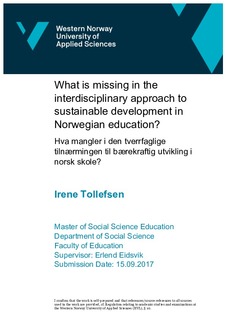| dc.description.abstract | Sustainable development is presented as one of three interdisciplinary topics to be prioritized in the current renewal process of Norwegian education. As an important, 30 year old and highly relevant topic of our time, sustainable development entails a growing number of dimensions, discourses, views, interests and values. When incorporating this topic into Norwegian education as one of three interdisciplinary topic, it is of interest to see what dimensions, discourses, views, interests and values are reflected in the description of the concept in relevant renewal documents. The research questions are as follows: 1. What is Education for Sustainable Development said to entail according to the Norwegian ESD strategies? 2. Which views of Sustainable Development can be uncovered in documents of the renewal process, and how do they compare to the content of the strategies? 3. What are the potential implications of the present views on; the concept of Sustainable Development an Education for Sustainable Development? These research questions are assessed through the use of a post-political theory framework and with departure in critical realism. The analytical tool is based on the discursive work of Espen Kummeneje (2016) from which terms and concepts are used as indicators to reveal which views are present and how. Interviews have been conducted to both understand the Norwegian context of SD and ESD, to better explain the indicators, what they reveal of the views, and how the present views can be explained. As some if the informants are key actors in the Norwegian SD “landscape”, they voluntarily participate under full name.
The first research questions finds that the Norwegian ESD strategies describes an education which entails a local and global perspective where challenges are analysed from an environmental, social and economic dimension perspective. This also includes a multiplicity of methods that encourages critical thinking addressing conflicts of interests and promotes active citizens in democratic processes. The latter strategy also emphasise a focus on the development dimension of sustainable development.
The second research questions reveals that views representing all of the dimensions are present, though the environmental dimension appears to define the main problem, and technology appears to be the main solution. The development and social dimension 2
indicators appears under-communicated, and indicators reflecting concepts of the economic dimension is either only briefly mentioned or not mentioned at all.
The third research questions about implications reveal that the present views neglect the importance of focusing on structures and conflicts of interests. Combined with the lack of focus on economic knowledge and understanding, the concept of SD, as presented in the renewal documents, stands at risk of losing ability to provide the necessary knowledge and options of choice to promote the critical and analytical thinking needed to understand how to create a sustainable development. | nb_NO |

